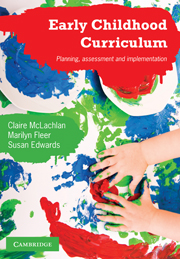Book contents
- Frontmatter
- Contents
- List of figures
- List of tables
- About the authors
- Acknowledgments
- Chapter 1 Introduction
- Chapter 2 Theory, research and the early childhood curriculum
- Chapter 3 Development and learning – how views of development shape how curriculum is framed
- Chapter 4 Curriculum as a cultural broker
- Chapter 5 Interpreting early childhood curriculum
- Chapter 6 Cultural-historical curriculum in action
- Chapter 7 Curriculum as a conceptual tool: Observation, content and programming
- Chapter 8 Assessing children and evaluating curriculum: Shifting lenses
- Chapter 9 Content knowledge: The sciences, maths and numeracy
- Chapter 10 Content knowledge: Language, literacy and ICT
- Chapter 11 Content knowledge: The arts and health, wellbeing and physical activity
- Chapter 12 Conclusions
- Index
Chapter 8 - Assessing children and evaluating curriculum: Shifting lenses
- Frontmatter
- Contents
- List of figures
- List of tables
- About the authors
- Acknowledgments
- Chapter 1 Introduction
- Chapter 2 Theory, research and the early childhood curriculum
- Chapter 3 Development and learning – how views of development shape how curriculum is framed
- Chapter 4 Curriculum as a cultural broker
- Chapter 5 Interpreting early childhood curriculum
- Chapter 6 Cultural-historical curriculum in action
- Chapter 7 Curriculum as a conceptual tool: Observation, content and programming
- Chapter 8 Assessing children and evaluating curriculum: Shifting lenses
- Chapter 9 Content knowledge: The sciences, maths and numeracy
- Chapter 10 Content knowledge: Language, literacy and ICT
- Chapter 11 Content knowledge: The arts and health, wellbeing and physical activity
- Chapter 12 Conclusions
- Index
Summary
This chapter will examine the relationship between observation, assessment and evaluation. The interrelated nature of assessment and evaluation is explored, along with the implications of that for the roles of teachers, children, families and communities. We will examine how one curriculum leader in one school generates a school-based curriculum and works with state and federal education systems to assess children and evaluate curriculum. We will explore how a school can combine school and community needs with departmental curriculum evaluation and assessment imperatives. In the first part of this chapter, the concept of assessment is further elaborated (building on Chapter 7), in order to build a context for discussing the relationships between assessment and curriculum evaluation.
WHAT DO WE MEAN BY ASSESSMENT?
In the previous chapter, we discussed how teachers in Australia, New Zealand and internationally are using observation and narrative methodologies as a way of documenting their observations of children learning. We also made the point that observation has been a primary means of assessment in many early childhood settings for many years. In primary schools, a wider range of assessment methods have typically been used, but there continues to be enormous debate around which methods should be used with younger children (see, for example, Brassard & Boehm 2007).
In his seminal paper on assessment, Crooks (1988) defined the reasons why we assess:
Selection and placement: for working out which children or adults should progress or in which groups they should be placed.
[…]
- Type
- Chapter
- Information
- Early Childhood CurriculumPlanning, Assessment, and Implementation, pp. 130 - 156Publisher: Cambridge University PressPrint publication year: 2010



